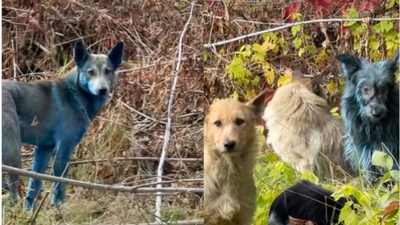Blue dogs of Chernobyl: Mystery behind the viral video of blue-furred dogs sparks concern on social media

A startling video circulating on social media shows several stray dogs roaming near the Chernobyl Exclusion Zone in Ukraine with bright blue fur. The clip has sparked concern and speculation about radiation mutations, toxic exposure, and wildlife evolution. But the reality turns out to be more nuanced and less dramatic than the headline suggests.
What’s going on?
According to reports, a nonprofit organisation called Dogs of Chernobyl (affiliated with the Clean Futures Fund) says they came across three dogs with entirely blue-colored fur as they were sterilising strays within the exclusion zone. The dogs are descendants of pets abandoned after the 1986 nuclear disaster. Local sources reported the dogs’ fur had been “normal” just a week earlier, adding to the mystery. The organisation emphasises the dogs appear healthy and active despite their unusual colouring. “We are on the ground now catching dogs for sterilization, and we came across three dogs that were completely blue,” the organization said in an Instagram post. The video has been viewed more than 330,000 times.
What isn’t the explanation
There is no verified evidence yet that the blue colouring is due to radiation-induced mutation. Experts caution against drawing that conclusion.It is not confirmed that the phenomenon is widespread — the reports currently cover just a handful of animals.
Possible causes
Here are plausible explanations being considered by the investigators and animal-rescue workers:Chemical contamination: The dogs may have come into contact with a dye, paint, or another chemical that stained their fur blue. The rapid change (normal fur a week ago) supports this theory.Environmental pigment absorption: In rare cases animals traversing contaminated soils, sediments or water with unusual minerals might display coloured fur or skin.Genetic/physiological change: While the researchers of a 2023 study found remarkable genetic differences in dogs living inside the zone versus outside, the changes were linked to radiation-tolerance genes—not sudden blue fur.
Why it’s so captivating
The idea of “blue dogs in Chernobyl” immediately triggers strong imagery — nuclear disaster + mutated wildlife = compelling story.It taps into our fears about radiation, environmental damage, and humanity’s long shadow on nature.Viral videos and images amplify the sensational side, even though the facts are still emerging.It offers a sort of real-life “science fiction” twist: animals changed by their environment in bizarre ways.
Chernobyl disaster
On April 26, 1986, a late-night safety test at Reactor 4 of the Chernobyl Nuclear Power Plant in Ukraine went horribly wrong. The reactor exploded, spewing radioactive material across Europe. Firefighters rushed in, not even realizing how deadly the radiation was — many of them never came home. The nearby town of Pripyat, once full of laughter and kids on bikes, was emptied overnight. People left everything behind — toys, photos, lives. Decades later, Chernobyl is still a ghost zone, frozen in time. Nature has crept back in — wild animals roam the empty streets, trees grow through buildings — but the scars remain. It’s a haunting reminder of how one human mistake can echo through generations, reshaping lives and landscapes forever.





